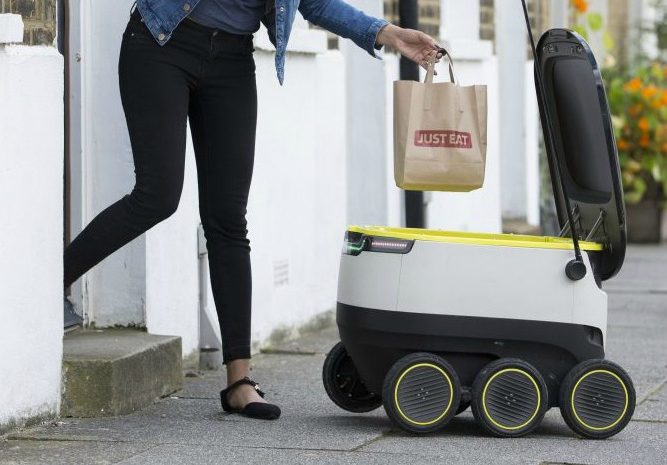Why the last mile is the most exciting part of retail right now

US retail behemoths Walmart and Amazon are setting the pace for all other retailers, with a constant pipeline of ‘last mile’ innovations in a bid to offer the best speed, convenience and communication for retail customers.
The most difficult (and costly) part of any consumer delivery is that last mile. Which is why retail giants around the globe are feverishly hunting for cutting-edge solutions to satisfy impatient consumers demanding lightning-fast delivery options.
Amazon now delivers purchases into your car boot for free. The new service works in tandem with the Amazon Key app and allows members to shop on Amazon then click in the in-car delivery option at check-out. And it’s delighting customers.
Amazon also purchased a doorbell business earlier this year, stumping retail pundits. But this wasn’t any doorbell company – Ring is a video doorbell startup with facial recognition.
Ring enables Amazon to unlock consumer preferences while the delivery guy unpacks groceries on the kitchen bench. Amazon’s team member will literally be able to see if the customer needs a new fridge, for example, opening up cross-promotion opportunities from other advertisers.
Not one to be left behind, Walmart started rolling out grocery delivery to an expanding number of regions this year using on-demand, third-party delivery platforms like Doordash and Postmates. Acknowledging that two major components for a successful last-mile delivery program include execution software and accessible fleet.
And in Germany, DHL has been trialling ground-based robots to do some of the heavy lifting for postal workers. Standing 150cm tall, the PostBOT scurries along at up to 6km/hour and can carry up to 150kg of mail, freeing up the hands of mail carriers to make it easier to distribute the mail.
Last mile innovations down under
Here in Australia, convenience store giant 7-Eleven recently acquired a majority stake in local alcohol delivery startup Tipple, granting it access to the startup’s proprietary delivery platform. The company admitted that convenience is changing and that the land grab gave it a solid nudge into offering online convenience.
Athlete’s Foot’s parent company Accent Group recently launched same-day delivery across its entire shoe retailer network. It operates 350 stores across the country under nine brands, including Athletes Foot, Hype DC, Sketchers, Platypus and Vans. Orders will be dispatched from the company’s individual bricks-and-mortar stores.
Meanwhile, drones delivering parcels might sound a little far-fetched, but perhaps not. Australia Post announced a two-week trial of using remotely piloted drones with the backing of the Civil Aviation Safety Authority.
The postal giant said the technology would be especially valuable for rural customers whose homes are far away from their letterboxes, which put the possibility on the public radar. Aviation laws in Australia don’t currently allow drones to be used in this way, but it’s only a matter of time before commercial initiatives will force legislative changes.
While a robotic delivery workforce could be part of the last mile landscape, it won’t be for some years.
The shift is already here
It’s paramount that Australian retailers both recognise and join the innovation journey. And rather than think about two-day delivery as acceptable, they need to think about two-hour delivery windows as standard.
Failure to adapt and innovate could ultimately result in systemic failure, just like US-based toy retailer Toys R Us, which dragged down its Australian arm with it earlier this year.
Retailers need to understand that the rise in fast delivery models for everything from grocery to high-end fashion is well within reach.
Retailers need to consider how to facilitate fast delivery, with three core options being explored by industry leaders:
• Delivery with existing supply chains, either their own workforce or contracted to a third-party;
• Freelance or on-demand delivery models, which provide speed and convenience, albeit at a higher marginal cost, and;
• Utilising a retailers’ own internal resources (employees) to drop goods on the way home from work.
These options are being considered and, in some cases, implemented by many Australian retailers chasing the two-hour window. Before long, supermarkets, fashion and bespoke retailers will follow the lead of online retail juggernauts like The Iconic, which offers a three hour delivery window in Sydney.
These emerging market plays will give rise to the need for an increase in reliable networks of on-demand couriers and agile supply chains as retailers hunt for the best way to tackle consumer demand for speed, whilst retaining control over the customer digital journey.
Store-based fulfilments will also grow in popularity as retailers look for new ways to pick up the pace using existing infrastructure.
These services will be paramount as retailers grapple with the best way to implement systems and best-fit models that offer convenience, great customer communication and speed.
Because at the end of the day, this will be the name of the game.
Brenton Gill is the managing director of Radaro, an enterprise technology platform for last mile delivery of goods and services.
Comment Manually
You must be logged in to post a comment.

No comments